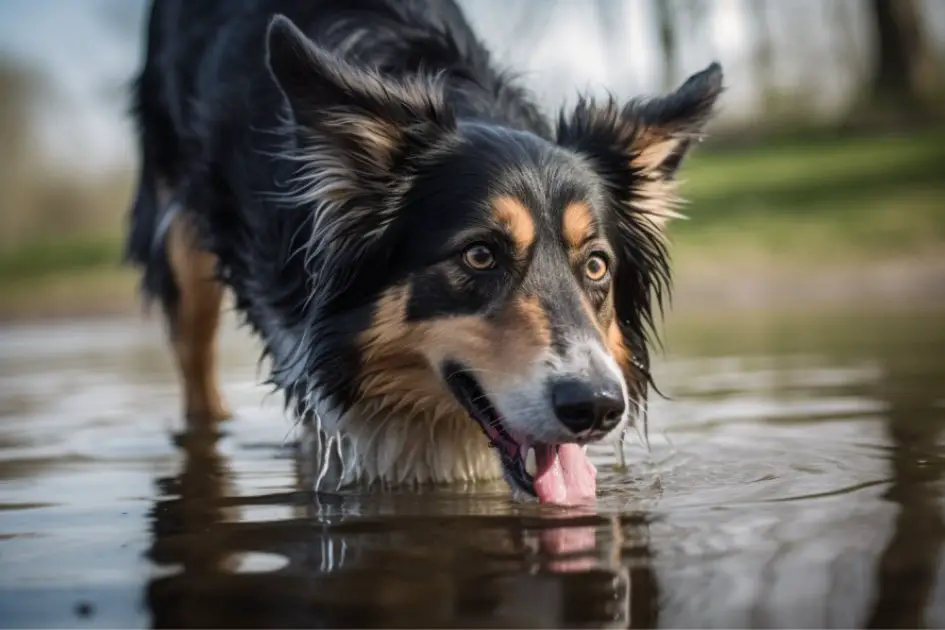Why Is My Dog Drinking So Much Water? (Insights & Solutions)

It’s not uncommon for dog owners to notice their furry friends drinking more water than usual, leading to concerns about their pet’s health. There are various reasons why a dog might increase its water intake, ranging from simple changes in the environment to underlying medical issues.
One reason for increased water consumption could be a change in diet or exercise, as these factors affect a dog’s hydration needs. For instance, switching to a dry or salty food, or engaging in more physical activity can cause them to drink more water. On the other hand, excessive thirst in dogs, also known as polydipsia, might indicate an underlying health problem such as diabetes, kidney disease, or hormonal imbalances.
It’s essential for dog owners to closely monitor their pet’s water intake and consult their veterinarian if they notice any sudden or persistent changes. Early detection and treatment of underlying causes can significantly improve a dog’s overall health and wellbeing, ensuring they remain happy and hydrated companions.
Causes of Excessive Thirst in Dogs
Excessive thirst in dogs, also known as polydipsia, can be caused by various factors. In this section, we will discuss some common causes, including medical conditions, medications, and environmental factors.
Medical Conditions
Several medical conditions can lead to excessive thirst in dogs. These include:
- Dehydration: This occurs when a dog loses more fluids than it takes in, often due to diarrhea or fever.
- Diabetes mellitus: A hormonal disorder that affects a dog’s ability to regulate blood sugar levels, leading to increased urination and thirst.
- Kidney disease: Impaired kidney function can cause dogs to drink more to compensate for the loss of fluids through increased urination.
- Cushing’s disease: A hormonal disorder that causes the body to produce excessive amounts of cortisol, leading to increased thirst and urination.
- Diabetes insipidus: A rare condition where the body cannot properly regulate water balance, resulting in excessive thirst and urination.
- Hypercalcemia: Elevated calcium levels in the blood can trigger increased urination and thirst in dogs.
Age can also be a factor in excessive thirst, with puppies and senior dogs being more prone to certain health problems that cause polydipsia.
Medications
Some medications can cause excessive thirst in dogs as a side effect. These include:
- Diuretics: These drugs increase urine production, leading to more frequent urination and increased thirst.
- Corticosteroids: Steroid medications can cause increased thirst and urination in dogs.
- Anti-seizure medications: Some medications used to treat epilepsy can also increase thirst in dogs.
Environmental Factors
Environmental factors that can contribute to excessive thirst in dogs include:
- Heat: Dogs may drink more water on hot days or when they are in warm environments, to help regulate their body temperature.
- Anxiety: Stressful situations can cause dogs to drink more water as a coping mechanism.
- High-salt diet: Consuming a diet with high salt content can make dogs thirstier.
It is essential to monitor your dog’s water intake and consult a veterinarian if excessive thirst persists. This can help identify any underlying health problems and determine the appropriate treatment.
Diagnosing the Cause
In order to determine the reason behind your dog’s excessive water consumption, it’s essential to consult with a veterinarian and perform necessary tests. This process usually involves a thorough veterinary examination followed by blood and urine tests.
Veterinary Examination
A veterinary examination is the first step toward diagnosing the cause of your dog’s increased water consumption. During this examination, the veterinarian will assess your dog’s overall health and ask questions about its medical history, recent changes in behavior, and any symptoms it may be experiencing. This information, combined with physical examination findings, can help narrow down potential causes and guide further testing.
Blood and Urine Tests
After the initial veterinary examination, the veterinarian may recommend blood and urine tests to identify any underlying health issues causing your dog’s excessive thirst. These tests include:
- Complete Blood Count (CBC): A CBC is a common blood test that evaluates the number and types of cells in your dog’s blood. It can help detect anemia, inflammation, infection, and other health issues.
- Serum Chemistry Profile: This blood test measures the levels of various chemicals and electrolytes in the blood, such as potassium and sodium, which are important for maintaining proper hydration and other bodily functions.
- Urinalysis: A urinalysis examines your dog’s urine for the presence of abnormal substances, such as glucose or protein, which may indicate underlying health problems. It can also evaluate the urine’s concentration, pH, and presence of red and white blood cells or bacteria.
By conducting these tests, veterinarians are better equipped to accurately diagnose the root cause behind your dog’s excessive water intake and formulate an appropriate treatment plan. It’s important to address the underlying problem quickly to prevent potential complications and ensure your dog’s overall health and well-being.

Treatments and Management
The management and treatment of a dog drinking excessive water depend on the underlying cause. It is essential to first consult with a veterinarian to properly diagnose the issue. This section covers medical treatments and lifestyle changes that can help dog owners manage their pet’s condition.
Medical Treatment
For conditions like diabetes, kidney failure, and liver disease, medical intervention may be necessary. Depending on the health condition, veterinarians may prescribe medications or recommend specific treatments to manage the issue. In some cases, dietary adjustments or weight loss plans may be advised to manage body weight and alleviate stress on the affected organs.
It is essential to follow the veterinarian’s recommendations closely, as skipping treatments or altering medication dosage might aggravate your dog’s condition or lead to further health issues. Regular follow-ups with your veterinarian are crucial to monitor your dog’s progress and adjust treatments as needed.
Lifestyle Changes
Some causes of excessive thirst might be addressed by lifestyle changes. Active dogs may require more water than sedentary ones, as they naturally lose more fluids through panting and sweating. Providing access to fresh, clean water and ensuring regular breaks during activities can prevent dehydration and excessive thirst.
Addressing pain and boredom, as well as managing stress, can help reduce excessive water consumption in some dogs. Environmental enrichment, proper exercise, and mental stimulation are important for maintaining overall wellbeing. Toys, puzzle feeders, and plenty of social interactions can alleviate boredom and reduce stress-related drinking.
Also, staying vigilant about your dog’s overall health and tracking any unusual behaviors can help identify potential health conditions early on, allowing for timely medical intervention and better management.
Preventative Measures
Managing your dog’s water intake is essential to prevent excessive drinking, which might indicate an underlying issue. The following preventative measures can help ensure your pet maintains a healthy water intake.
Firstly, establish a guideline for your dog’s daily water intake. Generally, a dog should consume around an ounce of water per pound of body weight daily. Adjustments can be made based on activity levels, size, and age.
Providing constant access to fresh water is crucial for your dog’s health. Ensure their water bowl is clean and filled with fresh water. Observe your dog’s drinking habits to detect any abnormal behavior early.
Avoid giving your dog high-sodium meals, as they can lead to increased thirst. Talk to your veterinarian about an appropriate diet that takes into account your dog’s specific needs.
Be mindful of warm climates or high levels of physical activity, which cause an increase in water consumption. Make sure to provide extra water, particularly during the summer months or after exercise.
Consider the type of food you are feeding your pet. Wet food has a higher moisture content than dry food, which can help maintain proper hydration while reducing the amount of water your dog drinks.
Conclusion
In conclusion, a dog drinking excessive amounts of water can be attributed to various factors. It’s essential for pet owners to monitor their dog’s water intake and consult a veterinarian if they notice any changes or suspect an underlying medical issue.
Some common reasons for a dog’s increased water consumption include:
- Hot weather or increased physical activity
- Changes in diet, such as consuming more dry or salty food
- Underlying medical conditions, like diabetes insipidus, kidney disease or Cushing’s disease
It’s crucial for pet owners to be aware of their dog’s normal water intake and to keep an eye out for signs of dehydration or overhydration. These conditions can cause serious health issues if left untreated. By being proactive, dog owners can ensure the health and well-being of their canine companions.






